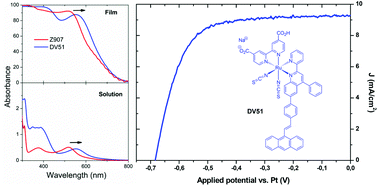Heteroleptic ruthenium(II) sensitizers DV42 and DV51, encompassing a novel unsymmetrical pyridine-quinoline hybrid ligand with extended π-conjugation, were synthesized, characterized, and utilized in nanocrystalline dye-sensitized solar cells. Due to the extended conjugation of DV42 and DV51, the absorption of the corresponding sensitized TiO2 films extends into the red spectral range, shifted by 30–40 nm relative to the absorption of TiO2 films sensitized with the standard Z907 ruthenium(II) dye. Contact angle measurements of DV42- and DV51-sensitized TiO2 films suggest that these films are hydrophilic with contact angle values commonly observed upon sensitization with the standard N3 ruthenium(II) dye. Electrochemical studies of the novel ruthenium(II) dyes show that their first oxidation potentials lie well below the I−/I3− redox potential allowing easy regeneration. The excited-state oxidation potentials of both dyes lie above the TiO2 conduction band, permitting efficient electron injection from the excited dye molecules into the semiconductor conduction band. Liquid electrolyte dye-sensitized solar cells incorporating DV42- or DV51-sensitized TiO2 photoelectrodes afford overall power conversion efficiencies of 3.24 or 4.36% respectively. These efficiencies are up to 56% of the power conversion efficiencies attained by TiO2 photoelectrodes sensitized by the benchmark Z907 ruthenium(II) dye under similar experimental conditions.

You have access to this article
 Please wait while we load your content...
Something went wrong. Try again?
Please wait while we load your content...
Something went wrong. Try again?


 Please wait while we load your content...
Please wait while we load your content...